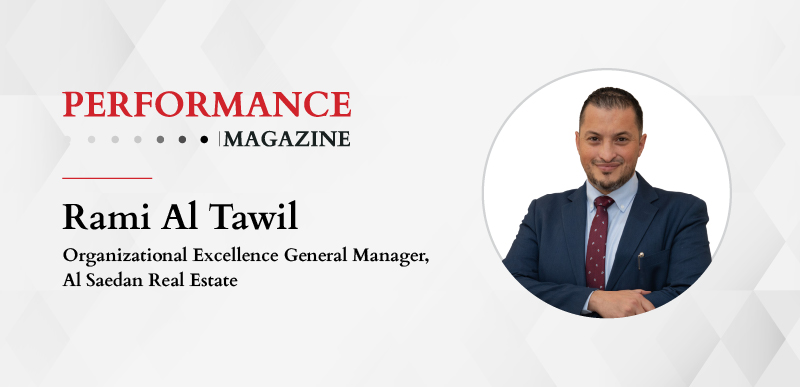Practitioner interview: exploring trends and best practices for organizational excellence

Discover insights from Rami Al Tawil, General Manager of Organizational Excellence at Al Saedan Real Estate Company, as he shares expertise honed over nearly two decades. With a master’s degree in industrial engineering from Jordan University of Science and Technology, Rami specializes in aligning strategic visions with employee performance. In this interview, he shares his perspectives on cultivating best practices for achieving organizational excellence and the trends shaping performance management.
Trends
In your opinion, what are the key trends in organizational performance management in 2024?
Organizational performance management trends emphasize data-driven decision-making, continuous feedback loops, and employee-centric approaches. Remote work requires the adoption of virtual performance management tools, while agile methodologies and technology drive adaptability. This year, focus areas include employee well-being, skill development, and DEI considerations within performance frameworks.
Which of the existing trends, topics, or aspects within performance management have lost their relevance and/or importance in your opinion?
From my point of view, traditional annual performance reviews conducted without ongoing feedback and coaching are losing relevance. Organizations now prioritize continuous and dynamic performance management approaches. Employees and managers alike increasingly seek real-time feedback and coaching to drive growth and development.
What does the corporate performance management system of the future look like?
The corporate performance management system of the future integrates AI for data-driven insights and predictive analytics. It fosters continuous feedback and coaching, leveraging virtual platforms for remote collaboration. AI-driven tools facilitate personalized recommendations, enhancing efficiency and aligning individual goals with organizational objectives for agile adaptation and innovation.
What will be the major challenges in managing performance in the future and how should organizations prepare for them?
Major challenges in managing performance in the future include adapting to remote work dynamics, ensuring fairness and inclusivity in performance evaluations, and leveraging AI ethically. To address these challenges effectively, organizations must invest in virtual performance management tools, foster a culture of transparency and equity, and establish clear guidelines for AI use, respectively. Additionally, prioritizing employee well-being and skill development will be crucial for navigating evolving work environments and maintaining performance excellence.
How is technology impacting the way organizations conduct strategic planning and manage performance? Any specific tools you would like to mention?
Technology transforms strategic planning and performance management with tools like business intelligence software for data-driven insights, performance management software for goal-tracking, and AI for forecasting and trend analysis. Examples include Tableau, SAP BusinessObjects, Power BI, and Oracle Hyperion, which are empowering agile decision-making and operational efficiency in organizations.
How is sustainability impacting the way organizations conduct strategic planning and manage performance? Any specific aspects you would like to mention?
Sustainability drives organizations to integrate ESG factors into strategic planning and performance management. Key aspects include carbon footprint reduction, energy efficiency, waste management, ethical sourcing, diversity, and community engagement. Incorporating sustainability metrics allows for progress tracking, target setting, and brand reputation enhancement while meeting regulatory requirements and attracting investors.
Practice
What should be improved in the use of strategy and performance management tools to make an organization even more resilient to future crises?
Enhancing organizational resilience demands comprehensive improvements in strategy and performance management tools. This entails incorporating real-time data analysis, scenario planning, and integrated risk management. Cross-functional collaboration, flexible goal setting, and continuous improvement are essential, alongside employee empowerment and technology investment. Leadership commitment and learning from crises drive agile adaptation and proactive response, ensuring the organization remains robust amidst future challenges.
While navigating through these challenging times, what would you consider as a best practice in performance management?
During challenging times, a best practice in performance management involves frequent communication and feedback sessions between managers and employees to clarify expectations, assess progress, and provide support. Emphasizing flexibility in goal setting and adjusting performance metrics to reflect changing priorities is crucial. Additionally, fostering a supportive and transparent work environment where employees feel valued and empowered to contribute their best efforts improves overall resilience and adaptability.
How does benchmarking support the improvement of performance management and target setting systems?
Benchmarking enhances performance management and target setting by comparing an organization’s metrics with industry standards. It identifies areas for improvement, aligns goals with best practices, and fosters a culture of continuous learning. This process informs strategic decisions, setting realistic targets and driving overall performance improvement in line with industry benchmarks.
Read more: Ask Our Experts: choosing the right KPIs in measuring public services performance
Research
Which organizations would you recommend being observed due to their approach to managing performance and its subsequent results? Why?
Organizations renowned for their effective performance management approaches like Saudi Aramco, Saudi Basic Industries Corporation (SABIC), and Saudi Telecom Company (STC) are notable for their performance management practices. Saudi Aramco, as a global energy leader, emphasizes operational excellence and continuous improvement. SABIC, a diversified chemical company, focuses on innovation and sustainability. STC, a leading telecommunications provider, prioritizes customer-centric strategies and digital transformation. Studying their approaches offers insights into effective performance management.
Given their importance in practice, what aspects of performance management should be further explored through research?
Analyzing the impact of performance management practices on employee engagement and satisfaction offers insights for optimizing systems, enhancing motivation, and improving retention strategies. Understanding these dynamics is vital to create a conducive work environment that fosters long-term commitment and productivity among employees.
What are the key competencies of a successful business leader (C-level executive)?
The key competencies of successful C-level executives include strategic vision, leadership, decision-making, communication, adaptability, problem-solving, innovation, resilience, strategic networking, and trustworthiness. These competencies enable effective leadership, drive organizational success, and foster a culture of trust, innovation, and growth.
What are the key competencies of a strategy and performance manager to succeed nowadays?
The key competencies for strategy and performance managers include strategic thinking, data-driven decision-making, agility in adapting to change, effective communication, and leadership. They must excel in analytics, continuous improvement, fostering collaboration, and leveraging technology. Adaptability, resilience, and a focus on innovation are also crucial for success in today’s dynamic business environment.
What are the processes and tools you look at when differentiating a successful performance management system from a superficial one?
From a consultant’s perspective, it is crucial to analyze processes like goal setting, feedback mechanisms, and performance appraisal methods. Examining the integration of data analytics, employee development initiatives, and alignment with organizational strategy distinguishes a successful performance management system from a superficial one, with the former ensuring effectiveness and tangible results.
Discover more perspectives from practitioners in the realm of strategy and performance management here.

